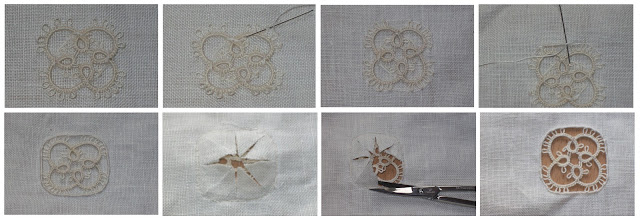venerdì 8 aprile 2016
Motif 1 and tatting diagram for curtains - Motivo 1 e schema chiacchierino per tende
This motif is very simple to make and it is perfect for beginners. Below there are the instructions, but here you can watch the video of the whole process.
Questo motivo è molto semplice da realizzare e si adatta perfettamente a chi è alle prime armi. Di seguito ci sono le istruzioni, ma qui potete vedere il video dell'intera lavorazione.
It is worked with two shuttles, starting from red R.
R of 4ds - 1p - 9ds - 1p - 9ds - 1p - 4ds. Close.
Make another ring as before and join the first p to the last p of the previous ring. Close and RW (Reverse Work).
C of 5ds - 1p - 5ds. RW.
Repeat the rings as before, joining the first p to the last one of the previous R.
C of 5ds, join to the p of the previous C, 5ds. RW.
Repeat two rings and a chain 4 times in total. Cut and tie.
Si lavora con due navette, iniziando dall'AN rosso.
AN di 4nd - 1p - 9nd - 1p - 9nd - 1p - 4nd. Chiudere.
Lavorare un altro anello come prima e unire il primo p all'ultimo p dell'AN precedente. Ch. e Volt.
AR di 5nd - 1p - 5nd. Volt.
Ripetere gli anelli come prima, unendo il primo p all'ultimo p dell'AN precedente.
AR di 5nd, att. al p dell'AR precedente - 5nd. Volt.
Ripetere due anelli e un arco 4 volte in totale. Tagliare e annodare i fili.
In this image you can see how this motif can be used, naturally this is an example only.
The motifs are made with two different colours and the lace is applied to the tissue with hidden stitches. The work is enriched with some hemstitch and an ornamental edging.
If you prefer can make the lace with one colour and apply it with the overcast stitch.
In questa immagine vedete come questo motivo può essere utilizzato, naturalmente è solo un esempio. I motivi sono lavorati con due colori diversi e il pizzo è applicato al tessuto con punti nascosti. Il tutto è arricchito con delle sfilature di punto a giorno e un orlo smerlato.
Se lo preferite potete realizzare il pizzo con un solo colore e applicarlo con il punto cordoncino.
martedì 5 aprile 2016
Overcast stitch - Il punto cordoncino
The tatting lace can be applied to the tissue with the overcast stitch, really it's kind of a cross between couching and satin stitch.
First of all the lace is fixed to the fabric by sewing the picots with a thin thread that will remain inside the overcast stitch. The stitches are very close and the needle goes from top to down. Then cut the fabric on the back of the work.
Il chiacchierino può essere applicato al tessuto con il punto cordoncino. Prima di tutto bisogna fissare il pizzo al tessuto cucendo i picot con un filo sottile che rimarrà all'interno del punto stesso.
I punti sono molto vicini tra loro e vanno eseguiti puntando l'ago dall'alto verso il basso. Infine occorre tagliare il tessuto sottostante il pizzo sul retro del lavoro.
First of all the lace is fixed to the fabric by sewing the picots with a thin thread that will remain inside the overcast stitch. The stitches are very close and the needle goes from top to down. Then cut the fabric on the back of the work.
Il chiacchierino può essere applicato al tessuto con il punto cordoncino. Prima di tutto bisogna fissare il pizzo al tessuto cucendo i picot con un filo sottile che rimarrà all'interno del punto stesso.
I punti sono molto vicini tra loro e vanno eseguiti puntando l'ago dall'alto verso il basso. Infine occorre tagliare il tessuto sottostante il pizzo sul retro del lavoro.
Iscriviti a:
Commenti (Atom)





